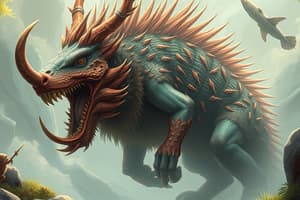Podcast
Questions and Answers
What is the main function of the notochord in chordates?
What is the main function of the notochord in chordates?
- To pump blood through the body
- To provide support for the skeleton and muscles (correct)
- To facilitate digestion in the digestive tract
- To act as a dorsal nerve cord
What is a characteristic shared by all chordates and vertebrates?
What is a characteristic shared by all chordates and vertebrates?
- A flexible rod along the dorsal side (correct)
- A muscular tail
- A backbone
- A digestive tract
Which of the following is NOT a characteristic of vertebrates?
Which of the following is NOT a characteristic of vertebrates?
- A dorsal nerve cord
- Improved respiration
- A notochord that persists throughout life (correct)
- Paired, muscular appendages
What is the location of the dorsal nerve cord in chordates?
What is the location of the dorsal nerve cord in chordates?
What is the term used to describe animals that do not have a notochord or backbone?
What is the term used to describe animals that do not have a notochord or backbone?
What is the primary function of pharyngeal gill slits in invertebrate chordates?
What is the primary function of pharyngeal gill slits in invertebrate chordates?
In which stage of development are pharyngeal gill slits present in higher vertebrates?
In which stage of development are pharyngeal gill slits present in higher vertebrates?
What is the function of pharyngeal gill slits in fish?
What is the function of pharyngeal gill slits in fish?
What is the muscular post-anal tail primarily composed of?
What is the muscular post-anal tail primarily composed of?
What is the primary function of the spinal cord in vertebrates?
What is the primary function of the spinal cord in vertebrates?
Flashcards are hidden until you start studying
Study Notes
Chordates
- Chordates are organisms that possess a notochord, a rod that extends most of the body length, during some part of their development.
- The notochord provides support and stiffens the body during locomotion.
Characteristics of Chordates
- A flexible rod (notochord) along the dorsal side to provide support for the skeleton and muscles.
- A common internal body plan.
- A dorsal nerve cord.
- A digestive tract that extends from the mouth to anus.
- A muscular tail that extends beyond the anus.
- A heart that pumps blood through the body and to the gills (or lungs).
Vertebrates
- Vertebrates are subdivided into several classes: Fishes, Amphibians, Reptiles, Birds, and Mammals.
- Vertebrates show progressive evolutionary adaptations to life on land and a wider range of ecological niches, including:
- Improved respiration.
- Protective and insulating body coverings.
- More efficient reproduction (especially on land).
- Paired, muscular appendages.
Basic Features of Chordates
- Notochord: lies dorsal to the alimentary canal and ventral to the nerve cord.
- Dorsal nerve cord: a fluid-filled tube of nerve tissue that runs the length of the animal, dorsal to the notochord.
- Pharyngeal gill slits: paired lateral clefts leading from the pharynx to the exterior.
- Muscular post-anal tail: extends backwards from behind the anus and is present at some time during a chordate's development.
Studying That Suits You
Use AI to generate personalized quizzes and flashcards to suit your learning preferences.




